
ЛЕВОБУПИВАКАИН КАБИ 2,5 мг/мл раствор для инъекций и для инфузий, генерик
Спросите врача о рецепте на ЛЕВОБУПИВАКАИН КАБИ 2,5 мг/мл раствор для инъекций и для инфузий, генерик

Инструкция по применению ЛЕВОБУПИВАКАИН КАБИ 2,5 мг/мл раствор для инъекций и для инфузий, генерик
Введение
Прошпект: Информация для пользователя
Левобупивакаин Кabi 2,5 мг/мл раствор для инъекций и инфузий ЕФГ
хлорид левобупивакаина
Прочитайте внимательно весь прошпект перед началом использования этого лекарства, поскольку он содержит важную информацию для вас.
- Сохраните этот прошпект, поскольку вам может потребоваться перечитать его.
- Если у вас есть какие-либо вопросы, проконсультируйтесь с вашим врачом или медсестрой.
- Если вы испытываете побочные эффекты, проконсультируйтесь с вашим врачом или медсестрой, даже если это побочные эффекты, которые не указаны в этом прошпекте. См. раздел 4.
Содержание прошпекта:
- Что такое Левобупивакаин Кabi и для чего он используется
- Что вам нужно знать перед тем, как вам будут вводить Левобупивакаин Кabi
- Как вам будут вводить Левобупивакаин Кabi
- Возможные побочные эффекты
- Хранение Левобупивакаина Кabi
- Содержание упаковки и дополнительная информация
1. Что такое Левобупивакаин Кabi и для чего он используется
Левобупивакаин Кabi относится к группе лекарств, называемых местными анестетиками. Этот тип лекарств используется для обезболивания частей тела или для облегчения боли.
У взрослых и подростков старше 12 лет:
Левобупивакаин Кabi используется в качестве местного анестетика для обезболивания частей тела перед крупной операцией (например, как эпидуральная анестезия при кесаревом сечении) и малой операции (например, на глазу или в полости рта).
Он также используется для облегчения боли
- после крупной операции
- во время родов
У детей (младше 12 лет):
Левобупивакаин Кabi также может быть использован у детей младше 12 лет для обезболивания частей тела перед операцией и для облегчения боли после малой операции, такой как грыжа паховая.
Левобупивакаин Кabi не был испытан у детей младше 6 месяцев.
2. Что вам нужно знать перед тем, как вам будут вводить Левобупивакаин Кabi
Не используйте Левобупивакаин Кabi:
- если вы аллергичны (гиперчувствительны) к левобупивакаину, к любому другому местному анестетику или к любому другому компоненту этого лекарства (указанному в разделе 6).
- если у вас очень низкое кровяное давление.
- для обезболивания части тела путем введения Левобупивакаина Кabi внутривенно.
- для облегчения боли путем введения его в область вокруг шейки матки (цервика) во время ранней фазы родов (парациркулярный блок).
Предостережения и меры предосторожности
Сообщите вашему врачу перед тем, как вам будут вводить Левобупивакаин Кabi, если у вас есть какие-либо из следующих состояний или заболеваний. Вам может потребоваться более тщательный контроль или введение меньшей дозы.
- если у вас есть сердечно-сосудистое заболевание
- если у вас есть заболевание нервной системы
- если вы слабы или больны
- если вы пожилой человек
- если у вас есть печеночная недостаточность.
Использование Левобупивакаина Кabi с другими лекарствами
Сообщите вашему врачу или медсестре, если вы принимаете, недавно принимали или можете принять любое другое лекарство. Сообщите им, особенно, если вы принимаете лекарства для:
- аритмии сердца (например, мексилетин)
- грибковых инфекций (например, кетоконазол), поскольку они могут повлиять на метаболизм Левобупивакаина Кabi.
- астмы (например, теофиллин), поскольку они могут повлиять на время, в течение которого Левобупивакаин Кabi остается в вашем организме.
Беременность и лактация
Если вы беременны или кормите грудью, считаете, что можете быть беременной или планируете стать беременной, проконсультируйтесь с вашим врачом перед использованием этого лекарства.
Левобупивакаин Кabi не должен быть использован для облегчения боли путем введения его в область вокруг шейки матки или цервика во время родов (так называемый парациркулярный блок).
Неизвестно, как Левобупивакаин Кabi влияет на плод во время первых трех месяцев беременности. Поэтому Левобупивакаин Кabi не должен быть использован во время первых трех месяцев беременности, если только ваш врач не считает это необходимым.
Неизвестно, проходит ли левобупивакаин в грудное молоко. Однако, согласно опыту с подобными препаратами, ожидается, что только небольшие количества левобупивакаина будут проходить в грудное молоко. Следовательно, грудное вскармливание возможно после использования местного анестетика.
Вождение и использование машин
Использование Левобупивакаина Кabi может иметь значительное влияние на вашу способность управлять транспортными средствами и использовать машины. Не следует управлять транспортными средствами или использовать машины до тех пор, пока все эффекты Левобупивакаина Кabi и эффекты операции не пройдут. Перед тем, как покинуть больницу, проконсультируйтесь с вашим врачом или медсестрой, можете ли вы управлять транспортными средствами или использовать машины.
Левобупивакаин Кabi содержит натрий
Это лекарство содержит 3,6 мг натрия (основного компонента поваренной соли) в каждом мл. Это эквивалентно 0,18% от максимально допустимой суточной нормы потребления натрия для взрослого.
3. Как вам будут вводить Левобупивакаин Кabi
Ваш врач введет вам Левобупивакаин Кabi в виде инъекции через иглу или через небольшую трубку, вставленную в вашу спину (эпидурально). Левобупивакаин Кabi также может быть введен в другие части тела для обезболивания области, которую необходимо лечить, такой как глаз, рука или нога.
Ваш врач и медсестра будут тщательно наблюдать за вами во время введения Левобупивакаина Кabi.
Ваш врач введет вам Левобупивакаин Кabi в виде инъекции через иглу или через небольшую трубку, вставленную в вашу спину (эпидурально). Левобупивакаин Кabi также может быть введен в другие части тела для обезболивания области, которую необходимо лечить, такой как глаз, рука или нога.
Доза
Количество Левобупивакаина Кabi, которое будет введено вам, и частота введения будут зависеть от того, для чего он используется, и от вашего физического состояния, возраста и веса. Вам будет введена минимальная доза, которая обеспечит обезболивание в необходимой области. Доза будет тщательно рассчитана вашим врачом.
Когда Левобупивакаин Кabi используется для облегчения боли во время родов или для кесарева сечения (эпидурально), введенная доза будет тщательно контролироваться.
Если вам будет введено больше Левобупивакаина Кabi, чем должно быть
Если вам будет введено больше Левобупивакаина Кabi, чем должно быть, вы можете испытать онемение языка, головокружение, размытое зрение, мышечные сокращения, тяжелую дыхательную недостаточность (включая остановку дыхания) и даже судороги. Если вы заметите любой из этих симптомов, немедленно сообщите вашему врачу. В некоторых случаях введение чрезмерного количества Левобупивакаина Кabi также может вызвать гипотонию, брадикардию или тахикардию и изменения сердечного ритма. Ваш врач может назначить вам другие лекарства для помощи в прекращении этих симптомов.
Если у вас есть какие-либо другие вопросы о использовании этого лекарства, проконсультируйтесь с вашим врачом или медсестрой.
4. Возможные побочные эффекты
Как и все лекарства, это лекарство может вызывать побочные эффекты, хотя не все люди испытывают их.
Немедленно сообщите вашему врачу или медсестре, если вы считаете, что испытываете любой из следующих побочных эффектов. Некоторые из побочных эффектов Левобупивакаина Кabi могут быть тяжелыми.
Очень часто(могут возникать у более 1 из 10 человек):
- чувство усталости или слабости, затруднение дыхания, бледность (это все признаки анемии)
- низкое кровяное давление
- тошнота
Часто(могут возникать у до 1 из 10 человек):
- головокружение
- головная боль
- рвота
- страдание плода
- боль в спине
- лихорадка
- послеоперационная боль
Частота неизвестна(частота не может быть оценена из доступных данных):
- тяжелые аллергические реакции (гиперчувствительность) с тяжелой дыхательной недостаточностью, затруднением глотания, крапивницей и очень низким кровяным давлением
- аллергические реакции (гиперчувствительность) с покраснением и раздражением кожи, чиханием, чрезмерным потоотделением, увеличением сердечного ритма, обмороком или отеком лица, губ, рта, языка или горла
- потеря сознания
- сommenение
- размытое зрение
- остановка дыхания
- блокада сердца или остановка сердца
- местное онемение
- онемение языка
- слабость мышц или дрожь
- потеря контроля над мочеиспусканием и дефекацией
- паралич
- судороги
- онемение, покалывание или другие необычные ощущения
- длительная эрекция полового члена, которая может быть болезненной
- неврологические расстройства, которые могут включать опущение век, сужение зрачков (центральная часть глаза), запавшие глаза, потоотделение и/или покраснение одной стороны лица.
Также были зарегистрированы как побочные эффекты брадикардия, тахикардия и изменения сердечного ритма, которые можно увидеть на электрокардиограмме (ЭКГ).
В очень редких случаях некоторые побочные эффекты могут возникать в течение длительного времени или становиться постоянными.
Сообщение о побочных эффектах
Если вы испытываете любой побочный эффект, проконсультируйтесь с вашим врачом или медсестрой, даже если это возможный побочный эффект, который не указан в этом прошпекте. Вы также можете сообщить о них напрямую через систему фармаковигиланса Испании: https://www.notificaram.es. Сообщая о побочных эффектах, вы можете внести свой вклад в предоставление более полной информации о безопасности этого лекарства.
5. Хранение Левобупивакаина Кabi
Храните это лекарство в недоступном для детей месте.
Не используйте это лекарство после даты истечения срока годности, указанной на упаковке после CAD. Дата истечения срока годности - последний день месяца, указанного.
Ваш врач будет хранить это лекарство для вас.
Раствор должен быть использован сразу после открытия.
Не используйте это лекарство, если вы заметите частицы в растворе.
Лекарства не должны быть выбрасываны в канализацию или мусор. Спросите вашего фармацевта, как утилизировать упаковку и лекарства, которые вам не нужны. Таким образом, вы поможете защитить окружающую среду.
6. Содержание упаковки и дополнительная информация
Состав Левобупивакаина Кabi
- Активное вещество - левобупивакаин (в виде гидрохлорида)
Левобупивакаин Кabi 2,5 мг/мл раствор для инъекций и инфузий: 1 мл раствора содержит 2,5 мг левобупивакаина (в виде гидрохлорида левобупивакаина). Каждая ампула по 10 мл содержит 25 мг левобупивакаина в виде гидрохлорида левобупивакаина.
- Другие компоненты - вода для инъекций, хлорид натрия и небольшое количество гидроксида натрия и соляной кислоты.
Это лекарство содержит вспомогательное вещество с известным эффектом (натрий). См. раздел 2 для более подробной информации.
pH: 4,0 - 6,0
Осмолярность: 271 - 372 мОсм/л
Внешний вид продукта и содержание упаковки
Это лекарство представляет собой прозрачный бесцветный раствор в ампулах из полипропилена в стерильных блистерах. Каждая ампула содержит 10 мл раствора. Он поставляется в упаковках по 5, 10 или 20 ампул.
Возможно, не все размеры упаковки будут продаваться.
Владелец разрешения на маркетинг и производитель
Владелец разрешения на маркетинг:
Fresenius Kabi España S.A.U
C/ Marina 16-18,
08005-Барселона
Производитель:
HP Halden Pharma AS
Svinesundsveien 80
1788 Халден
Норвегия
Это лекарство разрешено к маркетингу в государствах-членах Европейского экономического пространства под следующими названиями:
Название государства-члена | Название лекарства |
Бельгия | Левобупивакаин Фрезенус Кabi 2,5 мг/мл раствор для инъекций/инфузий |
Франция | Левобупивакаин Кabi 2,5 мг/мл раствор для инъекций/инфузий |
Ирландия | Левобупивакаин 2,5 мг/мл раствор для инъекций или инфузий |
Италия | Левобупивакаин Кabi |
Нидерланды | Левобупивакаин Фрезенус Кabi 2,5 мг/мл раствор для инъекций/инфузий |
Португалия | Левобупивакаин Кabi |
Словения | Левобупивакаин Кabi 2,5 мг/мл раствор для инъекций/инфузий |
Испания | Левобупивакаин Кabi 2,5 мг/мл раствор для инъекций и инфузий |
Великобритания | Левобупивакаин 2,5 мг/мл раствор для инъекций/инфузий |
Дата последнего пересмотра этого прошпекта: Октябрь 2018
Подробная и актуальная информация о этом лекарстве доступна на сайте Агентства по лекарствам и медицинским изделиям Испании (AEMPS) http://www.aemps.gob.es/
--------------------------------------------------------------------------------------------------------------------------
Эта информация предназначена только для медицинских работников:
Левобупивакаин Кabi2,5 мг/мл раствор для инъекций и инфузий ЕФГ
Инструкции по использованию/манипуляции
Левобупивакаин Кabi 2,5 мг/мл раствор для инъекций и инфузий предназначен только для одноразового использования. Неиспользованный раствор должен быть утилизирован. Используйте только если упаковка не повреждена.
Раствор/дилUTION должен быть визуально осмотрен перед использованием. Только прозрачные растворы без видимых частиц должны быть использованы.
При необходимости стерильной поверхности ампулы следует выбрать блистер стерильной упаковки. Поверхность ампулы не стерильна, если блистер стерильной упаковки повреждена.
ДилUTION стандартных растворов левобупивакаина должны быть выполнены с помощью раствора хлорида натрия 9 мг/мл (0,9%) с использованием асептических техник.
Было показано, что 8,4 мкг/мл клонидина, 50 мкг/мл морфина и 2-4 мкг/мл фентанила и 0,4 мкг/мл суфентанила совместимы с левобупивакаином в растворе хлорида натрия 9 мг/мл (0,9%).
Срок годности после первого открытия: Продукт должен быть использован сразу.
Срок годности после дилUTION:
Была показана химическая и физическая стабильность Левобупивакаина Кabi, дилутированного с 9 мг/мл хлорида натрия (0,9%) до конечной концентрации 0,625 мг/мл и 1,25 мг/мл, соответственно, в течение 30 дней при 2-8°C или 20-25°C.
Была показана химическая и физическая стабильность Левобупивакаина Кabi, дилутированного с 9 мг/мл хлорида натрия (0,9%) до конечной концентрации 0,625 мг/мл и 1,25 мг/мл, соответственно,
- с 8,4 мкг/мл гидрохлорида клонидина, 50 мкг/мл сульфата морфина и 2-4 мкг/мл цитрата фентанила в течение 30 дней при 2-8°C или 20-22°C.
- с суфентанилом, добавленным в концентрации 0,4 мкг/мл, в течение 30 дней при 2-8°C или в течение 7 дней при 20-22°C.
С микробиологической точки зрения, продукт должен быть использован сразу. Если он не используется сразу, сроки хранения для использования и условия до использования являются ответственностью пользователя и обычно не должны превышать 24 часа при 2-8°C, если только дилUTION и смешивание не были подготовлены в контролируемых и проверенных асептических условиях.
Левобупивакаин Кabi не должен быть смешан с другими лекарствами, кроме указанных выше. Разбавление с щелочными растворами, такими как бикарбонат натрия, может привести к осаждению.
Опыт безопасности лечения левобупивакаином в течение более 24 часов ограничен.
Способ введения
Введение Левобупивакаина Кabi должно быть выполнено только врачом, имеющим необходимую подготовку и опыт, или под его руководством.
Для информации о дозировке см. инструкцию по медицинскому применению.
Рекомендуется осторожная аспирация перед и во время инъекции для предотвращения внутривенного введения.
Аспирация должна быть повторена перед и во время введения дозы в болюс, которая должна быть введена медленно и в увеличивающихся дозах со скоростью 7,5-30 мг/мин, при этом необходимо контролировать жизненно важные функции пациента и поддерживать вербальный контакт с ним.
Если出现 симптомы токсичности, немедленно прекратите введение.
Левобупивакаин Кabi
(Левобупивакаин)
2,5 мг/мл
Прочитайте инструкции внимательно. Встряхните до тех пор, пока не будет удалено любое содержимое из горлышка.
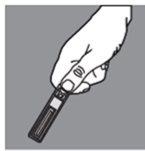
Держите ампулу в ладони руки на уровне талии. Держите стрелку на крышке ампулы между большим и указательным пальцами (с большим пальцем, обращенным наружу). Быстро и резко поверните ее к себе (против часовой стрелки).
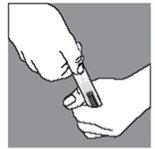
Нажмите конус Люэра шприцаfirmly в ампулу
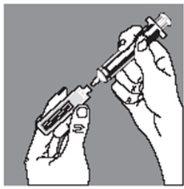
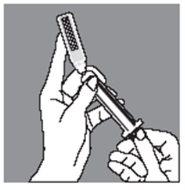
Нажмите ампулу мягко к себе указательным пальцем и медленно вытащите содержимое, обращая особое внимание на начало
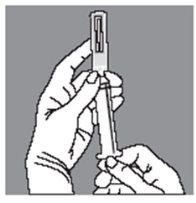
- Страна регистрации
- Активное вещество
- Требуется рецептДа
- Производитель
- Информация носит справочный характер и не является медицинской рекомендацией. Перед приемом любых препаратов проконсультируйтесь с врачом. Oladoctor не несет ответственности за медицинские решения, принятые на основе этого контента.
- Аналоги ЛЕВОБУПИВАКАИН КАБИ 2,5 мг/мл раствор для инъекций и для инфузий, генерикФорма выпуска: ИНФУЗИОННЫЙ РАСТВОР ДЛЯ ИНЪЕКЦИЙ, 0,625 мг/млАктивное вещество: levobupivacaineПроизводитель: Altan Pharmaceuticals SaТребуется рецептФорма выпуска: ИНЪЕКЦИОННЫЙ РАСТВОР ДЛЯ ИНФУЗИЙ, 1,25 мг/млАктивное вещество: levobupivacaineПроизводитель: Altan Pharmaceuticals SaТребуется рецептФорма выпуска: ИНЪЕКЦИОННЫЙ РАСТВОР, 5 мг/млАктивное вещество: levobupivacaineПроизводитель: Altan Pharmaceuticals SaТребуется рецепт
Аналоги ЛЕВОБУПИВАКАИН КАБИ 2,5 мг/мл раствор для инъекций и для инфузий, генерик в других странах
Лучшие аналоги с тем же действующим веществом и терапевтическим эффектом.
Аналог ЛЕВОБУПИВАКАИН КАБИ 2,5 мг/мл раствор для инъекций и для инфузий, генерик в Польща
Врачи онлайн по ЛЕВОБУПИВАКАИН КАБИ 2,5 мг/мл раствор для инъекций и для инфузий, генерик
Консультация по дозировке, побочным эффектам, взаимодействиям, противопоказаниям и продлению рецепта на ЛЕВОБУПИВАКАИН КАБИ 2,5 мг/мл раствор для инъекций и для инфузий, генерик – по решению врача и с учетом местных правил.














